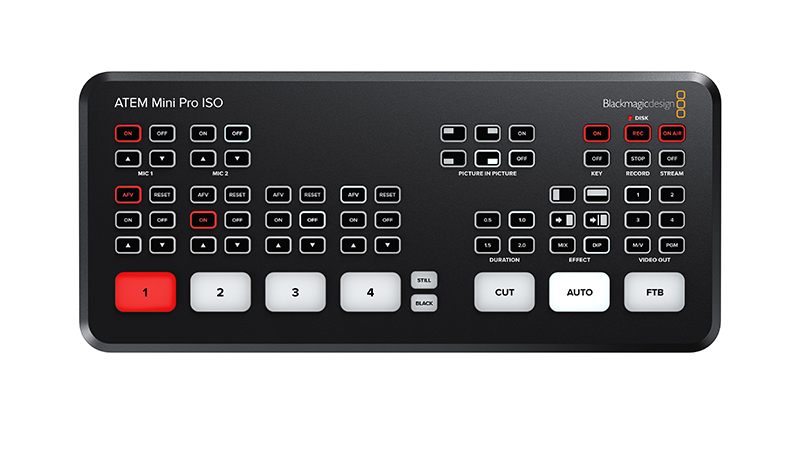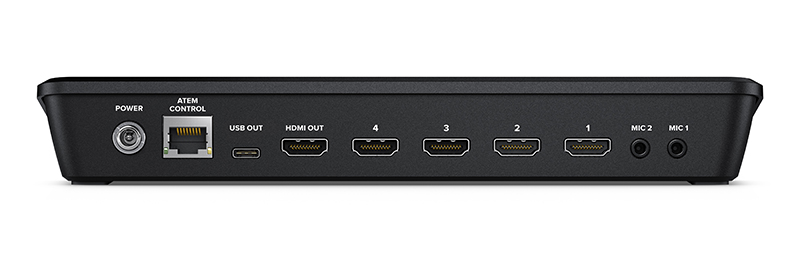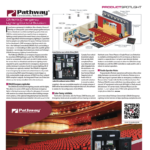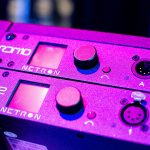
In a time when production should be getting more difficult, Blackmagic has managed to simplify the whole thing yet again.
From a production perspective, the one certainty that the pandemic has given us is that video is now a constant. Things were starting to go the “smaller, faster, more capable” route pre-pandemic, but Covid has ramped that effort up so that practically everybody who broadcasts from their basement is starting to look like semi-professionals. And why shouldn’t they? Switching and capture gear quality has grown leaps and bounds from even three years ago. When it comes to small operations (or even big ones), you really can look like a million bucks without spending that.
The ATEM Mini line of switchers from Blackmagic Design have not only kept up with that trend, they’ve blazed the way forward and pretty much dominate it now. I’ve used the Mini Pro for a while and absolutely love the ease of use and level of production it provides, but how to improve on it? The ATEM Mini Pro ISO, of course. For a slightly larger investment, your switcher can now provide you with the means to not only switch and stream, but record every input and line cut individually.

Around the Console
The Mini Pro ISO occupies the exact same frame as its other siblings (with the exception of the Extreme model) but has quite a few more tricks up its sleeve. It’s small as switchers go, but heavy, alluding to its build quality. It sits nicely on a desk and doesn’t move around when switching. It’s a 4-input HDMI switcher, and it’s laid out exactly like you’d think a switcher of this size would be, with input buttons on the left and CUT, AUTO, and FTB buttons on the right. Each input has a set of somewhat rudimentary control buttons above the main, and they allow quick access to features like AFV, reset and literally ON/OFF. Above these are two sets of Microphone control buttons. On the right are all the output control buttons.

Around the back we have four HDMI inputs, two 3.5mm stereo mini Mic inputs, HDMI out, USB C out and Ethernet. The HDMI out serves as either a Multiview out or a direct PGM feed. By using it as a Multiview out, you get the advantage of using an external monitor to see all cameras/inputs, while using the USB C out hooked to an SSD for 5 separate ISO recordings of all inputs (including the switched feed and all .WAV files). Use the Ethernet out to feed whatever service you’re streaming to and monitor your feed. Too easy.
With the ability to record all inputs, their respective audio, and a switched feed, what do you do with all of it? The Mini Pro ISO also generates a DaVinci Resolve config file, and dragging all of these into that particular software produces a glorious multi-input, time-aligned editing session. This feature alone is worth the upgrade to the Mini Pro ISO. I noticed that even when my main switched feed went inactive, the other ISO feeds all lined up in sync. If you use Blackmagic Cinema cameras, not only do you get to control them via the ATEM software, but your record files are also done in Blackmagic’s high-res format RAW.
The ability to wrangle media from a four input switcher with this kind of ease is really quite amazing and makes production in Covid times actually enjoyable.

Add In the ATEM Streaming Bridge
Of course, using the powerful ATEM software with the Mini Pro ISO makes all the difference. Yes, switching with software is cumbersome, not to mention error-prone, which is why I appreciate the build quality and button-feel of the ATEM line. While using the Mini Pro ISO hardware is intuitive and easy, driving the software from an external laptop provides a huge amount of advantages, though. Upload stills to the media player, use a Hyperdeck mini for another record or playback source, shade Blackmagic cameras, and set up all your upstream and downstream keying parameters. Having your Mini Pro ISO connected to a local network is also the key to using another piece of Blackmagic wizardry — The ATEM Streaming Bridge.
The ATEM Streaming Bridge is not a very fancy piece of gear, and it shouldn’t be. It has one job, and that’s to provide a clean, broadcast feed of your ATEM Mini Pro or Mini Pro ISO via HDMI or SDI to Ethernet, to anywhere — in your studio, basement or the world. Or from your local network, which is how I was able to test it. It’s a simple, small box the same size as their MiniConverter line of adapters. There is an Ethernet port, two SDI outputs, HDMI out, SDI Ref In and Ref In. Besides a few LED status lights and a power jack, that’s it. And it doesn’t do a whole lot of tricks. This is basically like having a satellite truck feed from back in the day. I hooked my Streaming Bridge up to my network and my ATEM setup software instantly recognized it. After a few easy configuration steps, I was viewing a clean feed of my ATEM Mini Pro ISO’s output on a monitor. Physical setup of the Streaming Bridge is dead easy. You can name your various streaming bridges with unique names for easier discovery and network use.
Why Is This a Huge Deal?
It means you can have clean, broadcast quality feeds all around your facility or video village setup. You can also send the ATEM’s .xml file to colleagues anywhere in the world, and they can have your feed. If they use that feed as an input to their switcher, you have a near real-time connection for meetings, podcasts or broadcast feeds. The possibilities are really endless, and in a time when production should be getting more difficult, Blackmagic has managed to simplify the whole thing yet again.
There are a number of models in the ATEM line, all with particular strengths, so finding one to fit your workflow will be easy. For me, the Mini Pro ISO with an ATEM Streaming Bridge is the exact right fit.
The MSRP for Blackmagic Design’s ATEM Mini Pro ISO is $895. For the ATEM Streaming Bridge, the MSRP is $245. For more information go to blackmagicdesign.com.


